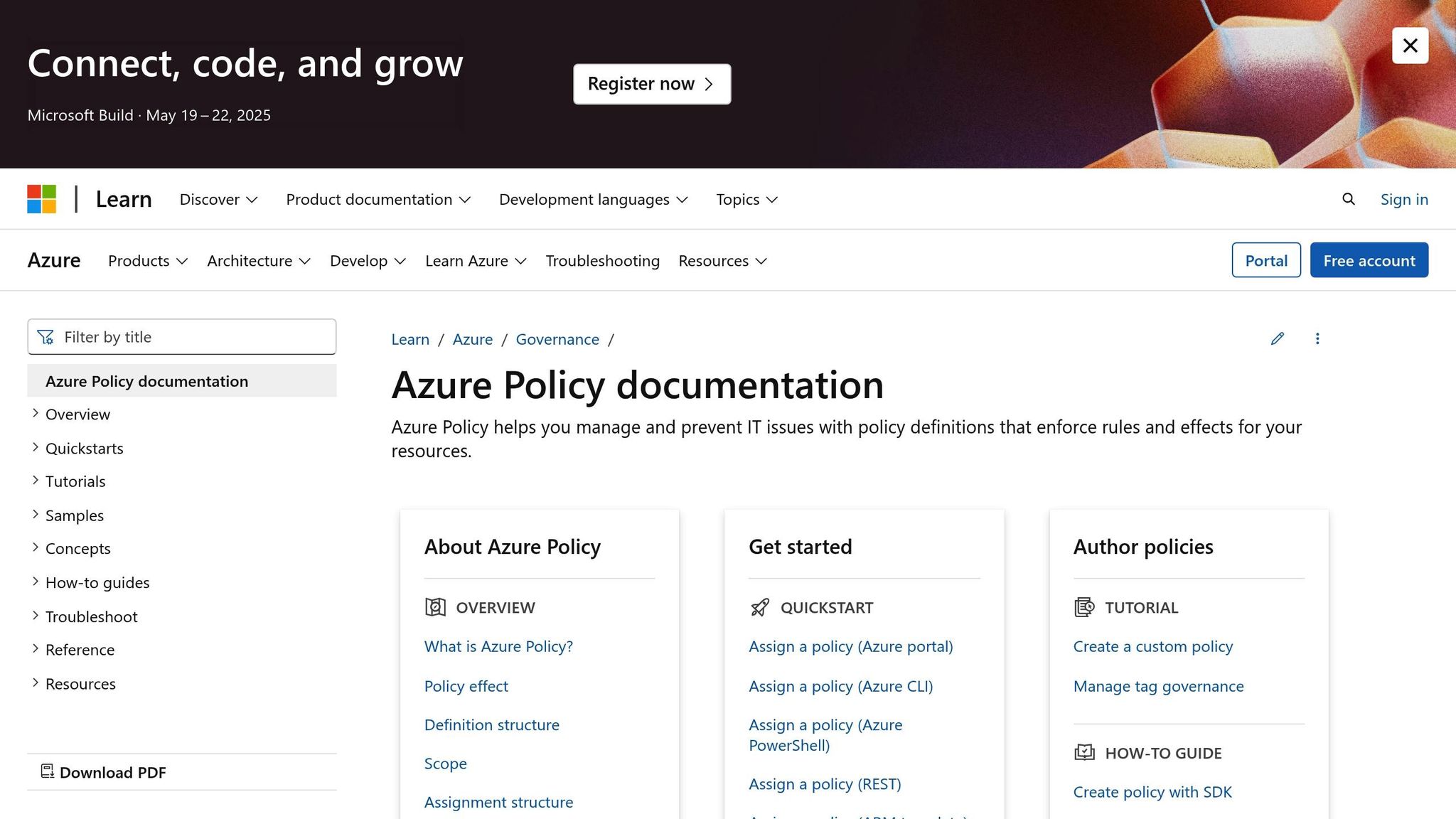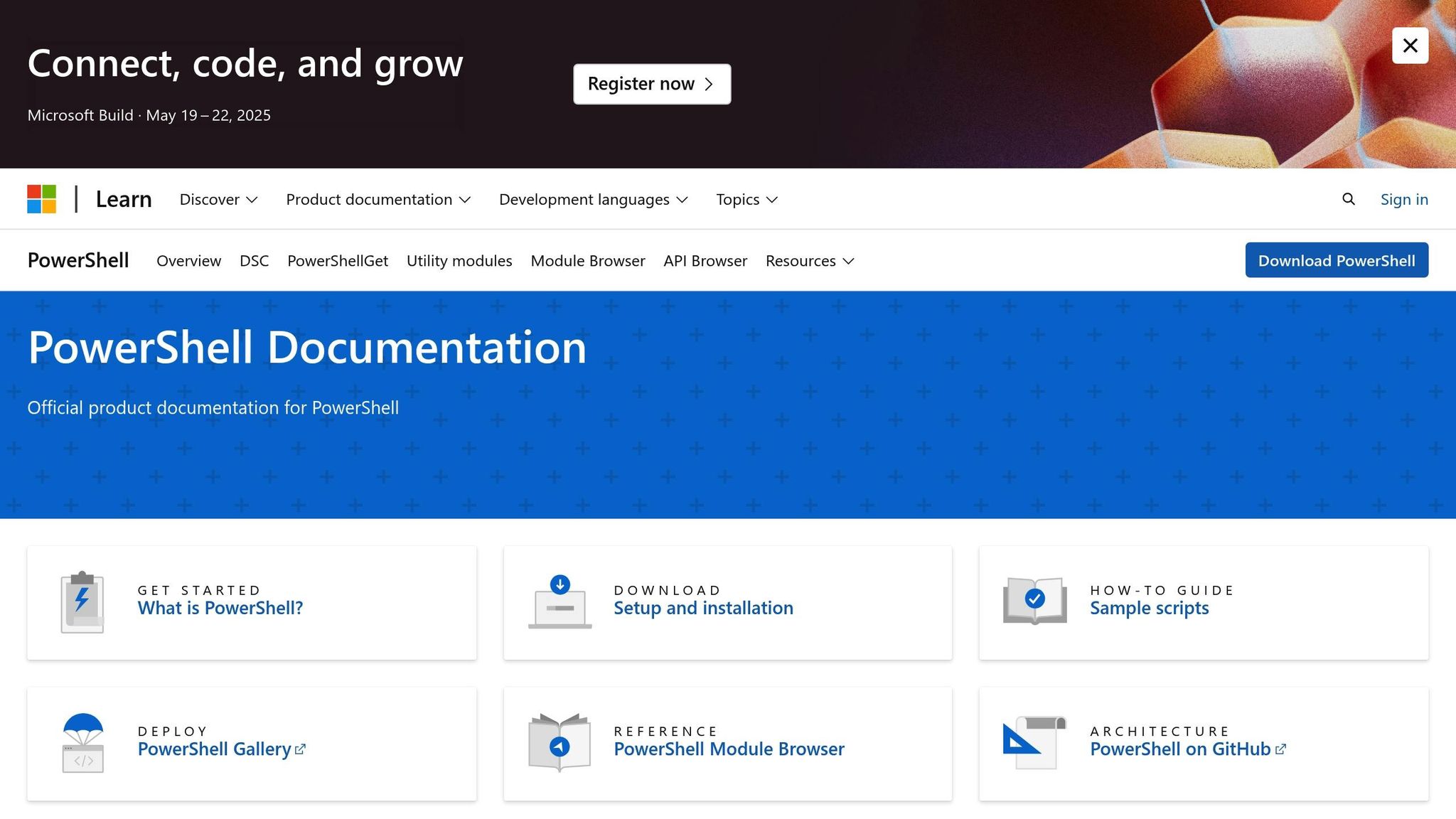Ultimate Guide to Azure Policy Automation
Automate governance in Azure with effective policy management to ensure compliance, reduce costs, and enhance security in your cloud environment.

Azure Policy helps you enforce rules and manage resources in your Azure environment automatically. It’s a tool designed to keep your cloud setup secure, compliant, and cost-effective, especially for small and medium-sized businesses (SMBs). Here’s a quick overview of what it does and how to get started:
-
Core Features:
- Policy Definitions: Set rules for compliance, security, and resource management.
- Policy Assignments: Apply rules to specific subscriptions or resource groups.
- Policy Effects: Choose actions like auditing, denying, or modifying resources.
-
Key Benefits:
- Cost Control: Prevent overspending by enforcing limits.
- Compliance Automation: Reduce manual checks with automated enforcement.
- Risk Reduction: Minimise errors in configuration and security.
- Standardisation: Ensure uniform resource deployment.
-
Getting Started:
- Identify governance and cost goals.
- Test policies in audit mode before enforcing them.
- Use built-in policies for common needs like tagging or location restrictions.
-
Automation Tools:
- Use PowerShell scripts for bulk deployments and compliance checks.
- Enable auto-fix settings to correct issues like missing tags or open network ports.
Azure Policy simplifies governance, reduces errors, and ensures compliance across your cloud resources. Start with broad rules at the management group level, and refine them as needed for subscriptions and resource groups.
Azure Policy - The Basics

Core Azure Policy Elements
Azure Policy's core elements provide a deeper understanding of how governance is enforced. These components ensure consistent management and compliance across your Azure environment.
Policy Rules and Actions
Policy rules evaluate specific resource properties, such as:
- Resource types and locations
- Tag requirements
- Network configurations
- Security settings
Actions define how Azure responds when resources are checked against these rules:
| Action Type | Purpose | Usage |
|---|---|---|
| Audit | Logs non-compliant resources | Useful for testing policies and tracking compliance |
| Deny | Prevents creation of non-compliant resources | Ensures security and cost control |
| DeployIfNotExists | Automatically creates required resources if missing | Guarantees baseline configurations are in place |
| Modify | Adjusts resource properties during deployment | Helps standardise tags and settings |
Policy Groups
Policy groups, also called initiatives, bundle related policies to address broader compliance needs. This approach:
- Groups multiple policies under a single assignment
- Simplifies management and reduces administrative effort
- Enables easier tracking of compliance
For example, the built-in initiative "Enable Monitoring in Azure Security Centre" includes over 100 individual policies designed for security compliance. Initiatives like this help streamline policy management and ensure a more organised setup.
Policy Setup and Scope
The scope of a policy defines where it is applied within your Azure hierarchy:
-
Management Group Level
Policies at this level apply to multiple subscriptions, ensuring organisation-wide standards. -
Subscription Level
These policies affect all resources within a subscription, maintaining consistency across projects. -
Resource Group Level
Policies here target specific workloads or environments within a resource group.
Best practices for policy setup include:
- Starting with broad policies at the management group level to establish organisation-wide rules
- Using subscription-level policies for project-specific needs
- Applying resource group policies for controls tailored to specific environments or workloads
These practices ensure a structured and efficient approach to Azure governance.
Setting Up Azure Policy
With your scope defined, the next step is deploying Azure Policy to align with your organisation's governance needs. A structured setup ensures policies are effective and tailored to your business requirements.
Testing with Audit Mode
Start with audit mode to evaluate how policies will impact your Azure environment without enforcing them. This approach helps you identify compliance gaps early.
- Check the compliance status of existing resources.
- Examine audit logs and fine-tune parameters as needed.
- Collaborate with key stakeholders to confirm the audit results.
Once you’ve reviewed the findings, adjust the policy parameters to better fit your environment.
Policy Parameters
Policy parameters allow you to create adaptable policies that can be reused in different environments. Focus on configuring these core parameters for better management:
- Resource Tagging Requirements: Define mandatory tags like Department, Environment, Cost Centre, and Project ID to streamline resource tracking.
- Location Restrictions: Limit resource deployment to specific regions to meet compliance needs and reduce costs.
- Resource Naming Conventions: Maintain uniform naming by including:
- Prefixes for resource types
- Indicators for environments (e.g., dev, prod)
- Sequential instance numbers
Policy Maintenance
As your Azure environment evolves, keeping policies up to date is crucial for maintaining effective governance.
- Regularly review and update policies, parameters, and assignments.
- Keep track of non-compliant resources and document any exceptions.
Use Azure's built-in compliance tracking tools to simplify monitoring and ensure consistent governance practices across your setup.
Policy Automation Methods
Automation simplifies governance for SMBs by reducing administrative work while maintaining the consistent and cost-efficient policies discussed earlier.
PowerShell Commands

PowerShell offers a powerful way to manage Azure Policies programmatically:
# Create a new policy assignment
New-AzPolicyAssignment -Name "RequireResourceTags" `
-PolicyDefinition (Get-AzPolicyDefinition -BuiltIn) `
-Scope "/subscriptions/{subscriptionId}"
Here’s how PowerShell scripts can help:
- Bulk Policy Deployment: Use loops to deploy policies across multiple subscriptions at once.
- Automated Compliance Checks: Set up Azure Automation runbooks to schedule compliance scans regularly.
- Custom Reporting: Create detailed compliance reports with the
Export-AzPolicyStatecmdlet.
To ensure better organisation and integration, store your scripts in version control systems and connect them to CI/CD pipelines.
Azure Policy also includes built-in auto-fix settings for maintaining real-time compliance without additional scripting.
Auto-Fix Settings
Auto-fix settings provide another layer of automation by addressing compliance issues as they arise.
-
Configure Managed Identities
Use system-assigned managed identities to securely enable remediation tasks.
# Enable remediation with managed identity $assignment = New-AzPolicyAssignment -Name "StorageHttps" ` -PolicyDefinition $definition ` -AssignIdentity -
Define Remediation Tasks
Set up tasks to automatically correct common compliance issues:
Compliance Issue Auto-Fix Action Missing Tags Apply required tags Incorrect SKUs Update to compliant SKU Open Network Ports Apply NSG rules - Schedule Regular Remediation Plan remediation tasks to run during change management windows, such as nightly, for minimal disruption.
Solving Common Issues
Policy Rules for Regulations
To align with regulatory requirements in Azure, map these rules to Azure Policy controls with careful planning. Here's a quick guide:
| Regulation Type | Policy Implementation | Validation Method |
|---|---|---|
| Data Protection | Enforce encryption at rest | Regular compliance scans |
| Resource Tagging | Require cost centre tags | Daily audit reports |
| Network Security | Apply NSG rules | Weekly security reviews |
Before enforcing these policies, test them in audit mode to identify any issues without disrupting operations.
Security Benchmark Setup
After mapping regulatory policies, address operational risks by implementing strong security benchmarks:
- Identity Management: Use multi-factor authentication (MFA) across your organisation. Automate the monitoring of privileged accounts to spot unusual activity.
- Network Security: Protect all public endpoints with a Web Application Firewall (WAF). Ensure virtual networks (VNets) are segmented correctly and service endpoints are properly configured.
- Data Protection: Encrypt storage accounts, maintain a regular backup schedule, and enable geo-redundancy for critical data to safeguard against potential data loss.
Compliance Tracking
Once security measures are in place, continuous tracking is key to maintaining compliance and preventing policy drift. Here's how to stay on top of it:
| Tracking Element | Frequency | Action Items |
|---|---|---|
| Compliance Reports | Regularly | Review and address non-compliances |
| Audit Logs | Regularly | Monitor for policy changes |
| Remediation Tasks | Regularly | Resolve recurring issues |
Set up Azure Policy to generate automated compliance reports. These reports should highlight non-compliant resources, identify trends across resource groups, and track the effectiveness of automated remediation efforts. This will ensure you stay compliant and address potential issues proactively.
Next Steps
To strengthen your governance framework, start by focusing on the automation methods we've covered. Here's a breakdown of actions to prioritise and implement:
| Priority | Action | Expected Outcome |
|---|---|---|
| High | Implement resource tagging | Enables tracking and ensures resource compliance |
| Medium | Configure VM shutdown policies | Cuts costs for non-production workloads |
| High | Apply encryption policies | Meets data protection standards for storage accounts |
Key Areas to Focus On
-
Security First
Set up encryption and multi-factor authentication. Automate monitoring for privileged accounts to enhance security. -
Cost Optimisation
Identify virtual machines that are larger than needed and set up alerts for budget thresholds. This helps keep costs under control. -
Compliance Framework
Build your compliance structure step by step. Use tagging, define security baseline policies, and automate reporting and remediation for lower-priority resources.
Make it a habit to review your Azure Cost Management data. This will help you spot areas where automation can further improve efficiency. Schedule monthly policy reviews to ensure your automation rules align with your business goals and compliance standards.
Use Built-In Azure Tools
Take advantage of these Azure tools to maintain compliance and manage costs effectively:
| Tool | Primary Use | Update Frequency |
|---|---|---|
| Azure Monitor | Tracks policy compliance | Daily |
| Cost Management | Analyses resource usage | Weekly |
| Security Center | Validates security policies | Real-time |
These tools can help you stay on track with compliance while keeping costs in check.
For more tips and practical advice, visit Azure Optimization Tips, Costs & Best Practices.
FAQs
How can I use Azure Policy to automate compliance and enhance security in my organisation?
Azure Policy is a powerful tool for ensuring compliance and improving security across your organisation's cloud environment. It allows you to define and enforce rules that automatically evaluate resources for compliance with your organisational standards. For example, you can use it to ensure all virtual machines have specific security configurations or to prevent the deployment of unapproved resource types.
To automate compliance, you can create policy definitions tailored to your requirements and assign them to resource groups or subscriptions. Azure Policy continuously evaluates resources against these policies, providing real-time insights and remediation options. This ensures your organisation remains compliant without manual intervention, saving time and reducing errors.
For SMBs aiming to scale effectively on Azure, combining Azure Policy with optimisation practices can further enhance cost efficiency and performance. By automating compliance and security, you can focus on growing your business while maintaining robust cloud governance.
How can I test and implement Azure Policies effectively to meet my organisation's governance requirements?
To ensure Azure Policies align with your organisation's governance goals, start by clearly defining your compliance requirements and objectives. Use Azure Policy's built-in definitions as a foundation and customise them to suit your specific needs. Testing is crucial - deploy policies in a non-production environment first to evaluate their impact and identify any unintended consequences.
When implementing, roll out policies gradually and monitor compliance through Azure Policy's compliance dashboard. This allows you to track adherence and address issues promptly. Regularly review and update policies to reflect changes in governance standards or business objectives, ensuring long-term effectiveness and alignment.
What are auto-fix settings in Azure Policy, and how do they help ensure compliance automatically?
Auto-fix settings in Azure Policy are designed to help organisations maintain compliance by automatically remediating non-compliant resources. Instead of relying on manual intervention, these settings take corrective actions whenever a policy violation is detected, ensuring your cloud environment stays aligned with your governance rules.
For example, if a policy requires all storage accounts to have encryption enabled and a new storage account is created without it, the auto-fix feature can automatically enable encryption. This not only saves time but also reduces the risk of human error, making it easier to enforce consistent compliance across your Azure environment.




